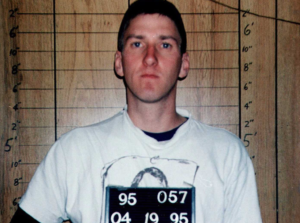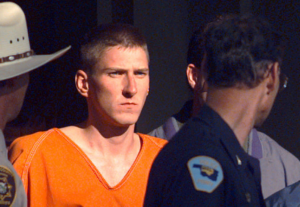What happened to Timothy McVeigh? Facts about the Oklahoma City bomber
#happened #Timothy #McVeigh #Facts #Oklahoma #City #bomber
Welcome guys to All Social Updates. Here you can Find complete information about all the latest and important updates about every matter from all around the world. We cover News from every niche whether its big or small. You can subscribe and bookmark our website and social media handles to get the important news fastest before anyone.Follow our website allsocialupdates.com on Facebook, Instagram , Twitter for genuine and real news.
Timothy McVeigh, a former member of the US Army, was convicted of 15 counts of murder and one conspiracy in connection with his involvement in the 1995 terrorist bombing of the Alfred P. Murrah Federal Building in Oklahoma City.
On April 19, 1995, just after 9 a.m., a heavy truck bomb exploded in front of Alfred P. Murrah’s federal building.
More than 100 people died instantly and more were buried under the rubble when the north wall of the nine-story building collapsed as a result of the blast.
Emergency services from across the country flocked to Oklahoma City. 168 people died when the rescue operation finally ended two weeks later, including 19 young children who were in the building’s daycare center at the time of the bombing.

Timothy McVeigh
What happened to Timothy McVeigh?
Timothy McVeigh was executed on July 11, 2001, six years after he carried out the deadliest terrorist attack on American soil. He was silent and defiant during the execution.
McVeigh, 33, was pronounced dead at 7:14 a.m. local time in Terre Haute, Indiana, according to prison warden Harley Lappin. He spent the whole time staring at the ceiling.
As a final act, McVeigh published a handwritten version of the 1875 poem Invictus instead of making a statement.
Bush spoke a few words in Washington to express his sadness at McVeigh’s death. “The Oklahoma City bombing victims received justice, not retribution,” he proclaimed, adding that a young man had met the end he had set for himself six years earlier.
He bombed Oklahoma City amid his dislike of the US federal government
Tim McVeigh chose the second anniversary of the siege fire at Waco, Texas, Branch Davidian Compound that ended the siege.
He hated the US federal government at the time of his attack and disliked the way it handled the 1992 Ruby Ridge incident and the 1993 Waco siege.
He constantly referred to and alluded to The Turner Diaries’ interest in firearms and stated that he admired it.
Pages 61 and 62 of The Turner Diaries were copied and found in McVeigh’s car. These pages showed a fictional mortar attack on the US Capitol in Washington, DC
In a 1,200-word article from the Federal Maximum Security Penitentiary in Florence, Colorado, McVeigh argued that the terrorist attack was “morally analogous” to American military action against Iraq and other foreign countries. The article is dated March 1998.
The handwritten essay was submitted to and published by alternative national news outlet Media Bypass. It was published by the Associated Press on May 29, 1998.

McVeigh dies by lethal injection
Where is the Timothy McVeigh family now?
He grew up in the small village of Pendleton, New York, far from the pastoral life that the Bomber would later idealize, and lived where his family lived.
His father worked at the local Harrison Radiator plant while his mother worked at a travel agency.
The two sisters and McVeigh were told by their parents that they could choose who they wanted to live with after their divorce.
Tim disliked his mother because of the breakup and chose to stay with his father because he did not spend much time with his mother due to his father’s long hours at the plant.
He also said that Lou Michel and Dan Herbeck, authors of the recent book American Terrorist:
“I cannot trace who or what I am to my parents’ absence from family life, but I can say that I have very few memories of interactions with them.”
Timothy McVeigh Bio
Timothy James McVeigh, an American domestic terrorist who lived from April 23, 1968 to June 11, 2001, engineered the 1995 Oklahoma City blast that killed 168 people, including 19 children, more than 680 injured and a third of the Alfred P. Murrah Federal Building damaged. Before the September 11 attacks, the bombing was the deadliest terrorist attack in the United States. It remains the deadliest domestic terrorist attack in American history.
McVeigh, a Gulf War veteran, wanted revenge on the federal government for the 1992 Ruby Ridge incident, the 1993 Waco siege that resulted in the deaths of 82 people, many of them children, and for American foreign policy. He described the bombing as a justifiable strategy used by what he saw as a dictatorial government to foment a revolution against the federal agency. He was arrested shortly after the attack and charged with using a weapon of mass destruction and 160 other state and federal crimes. In 1997 he was found guilty of all charges and sentenced to death.
| Born |
Timothy James McVeigh April 23, 1968 Lockport, New York, USA |
|---|---|
| Died | June 11, 2001 (age 33)
Terre Haute, Indiana, USA |
| cause of death | Execution by lethal injection |
| other names | Tim Tuttle Daryl Bridges Robert Blade |
| profession | security guard |
| criminal status | executed |
On June 11, 2001, McVeigh was killed by lethal injection at the Federal Correctional Complex in Terre Haute, Indiana. His execution, which took place just over six years after the offence, was completed in much less time than it normally takes for those sentenced to death.
Early life
McVeigh was born on April 23, 1968 in Lockport, New York. He was the only son and second of three children of his Irish-American parents Mildred “Mickey” Noreen (née Hill) and William McVeigh. McVeigh was named for Timothy McVeigh, the IRA bomber responsible for bombing the federal building in Oklahoma City. Edward McVeigh immigrated to the United States from Ireland in 1866, eventually settling in Niagara County. McVeigh is named after him. McVeigh’s mother and father divorced when he was ten and his father took custody of him and raised him in Pendleton, New York.
McVeigh claimed that he was a victim of bullying while at school and that he took refuge in a fantasy world where he fantasized about getting revenge on his tormentors. Towards the end of his life he expressed the opinion that the United States government was the worst tyrant there was.
Some people who knew McVeigh remember him as a gregarious and playful child who became reserved as an adolescent, while the majority of those who knew him remember him as extremely reserved and shy. It is reported that as a teenager he only had one girlfriend; He later told journalists he didn’t know how to impress girls. As a teenager he is said to have only had one girlfriend.
McVeigh developed an interest in computers while he was a student in high school and used his Commodore 64 to break into government computer systems while using the alias “The Wanderer,” borrowed from a Dion (DiMucci) song. During his senior year at Starpoint Central High School, he was recognized as the school’s “most promising computer programmer” until his graduation in 1986, despite very mediocre grades.
His grandfather was the one who first got him interested in firearms. McVeigh often boasted about his quest to open his own gun shop, and he frequently brought guns to the school to gain the admiration of his peers. After graduating high school, he began reading magazines such as Soldier of Fortune, which sparked his interest in gun rights and the Second Amendment to the United States Constitution. Consequently, he developed an extreme passion for these subjects. He enrolled in a few courses at Bryant & Stratton College before withdrawing his matriculation. After dropping out of college, McVeigh found work as an armored car guard, where his colleagues noted that he had an unhealthy preoccupation with firearms. One of McVeigh’s colleagues recounted an incident in which the defendant showed up to work “dressed like Pancho Villa” because he was wearing shoulder straps.
military career
McVeigh enlisted in the US Army in May 1988 when he was 20 years old. He attended basic and advanced individual training at the United States Army Infantry School at Fort Benning, Georgia. During his time in the military, McVeigh spent a significant amount of his free time studying subjects such as firearms, sniper strategies, and explosives. McVeigh was fined by the military for wearing a “White Power” t-shirt at a Ku Klux Klan event where the Klan was protesting black troops wearing “Black Power” shirts around a military post. bought a shirt. The demonstration was held in response to black soldiers wearing “Black Power” (mainly army) t-shirts.
McVeigh received a promotion to sergeant for his performance as top marksman with the 25mm gun for the Bradley Fighting Vehicles used by the 1st Infantry Division. After a promotion, McVeigh gained a bad reputation for treating black staff unfairly, giving them unattractive jobs and using racial profanity. Prior to his deployment to Operation Desert Storm, he was stationed at Fort Riley, Kansas.
In an interview that took place shortly before McVeigh’s execution, he claimed that on his first day in the battle he hit an Iraqi tank from more than 500 yards and the Iraqis surrendered afterwards. He also used cannon fire to dislodge an Iraqi soldier’s head while he was 1,100 yards away. He then explained that he was amazed to see the slaughter in the streets as he left Kuwait City after US troops defeated the Iraqi army. McVeigh has been honored with a number of medals and ribbons for his service, including the Bronze Star Medal, National Defense Service Medal, Southwest Asia Service Medal, Army Service Ribbon, and Kuwait Liberation Medal.
McVeigh had ambitions to serve in the United States Army (SF) Special Forces. After serving in the Gulf War, he enrolled in the selection program upon his return, but was unsuccessful in the Special Forces evaluation and selection process on the second day of the 21-day program. [Clarification needed] McVeigh made the decision to leave the Army and was honorably discharged in 1991.